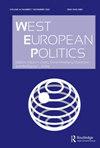Asylum seekers feel more welcome in counties with more foreign-born residents
IF 3.6
1区 社会学
Q1 POLITICAL SCIENCE
引用次数: 0
Abstract
AbstractEuropean countries are struggling with the largest inflows of asylum seekers since World War II, with ongoing debates about how best to promote asylum seeker integration. This article presents evidence from Germany which suggests asylum seekers feel more welcome when living in counties with more foreign-born residents. This relationship is stronger when asylum seekers and foreign-born residents have similar origins. Among Syrian asylum seekers, larger percentages of co-national residents are especially important. These findings have numerous implications that broaden our understanding of asylum seeker integration and engage debates about how to design asylum seeker reception policies. This article also contributes to broader debates about the relationship between geographic context and social and political attitudes.Keywords: Asylum seekerGermanyEuropemigrant integrationcontextual effects AcknowledgementsPrevious versions were presented at the University of North Carolina at Chapel Hill, the European University Institute, Aarhus University, the University of Copenhagen, the University of Sussex, the American Political Science Association annual conference, the University of Wisconsin-Madison, the University of California, Berkeley, Sciences Po, Harvard University, University College London, the University of California San Diego, the University of Amsterdam, and New York University. The authors would like to thank participants at each venue for excellent feedback that improved the article.Disclosure statementNo potential conflict of interest was reported by the author(s).Replication materialReplication materials for this article is available at: https://doi.org/10.7910/DVN/HZVI6INotes1 Ukrainian asylum seekers were more likely than Syrians to leave Western Europe and return home after a few months. Even so, there was a large influx of Ukrainian asylum seekers in 2022, and at the time of writing, their integration prospects remain uncertain.2 The underlying causal mechanism behind this relationship is an ongoing source of debate. Exposure to foreign-origin residents may make people who live in those communities more supportive of multiculturalism. However, people who support multiculturalism may select into communities with more foreign-origin residents.3 See http://www.bamf.de for an overview. See German Asylum Act (09.02.2008, last amended 03.11.2016) for full law.4 Respondents were able to choose from seven languages to conduct their interview, and translation was facilitated by a computer-assisted personal interviewing device (CAPI) – and a translation hot-line if necessary.5 State fixed effects account for the federal structure of German government, including potential differences in reception and processing of asylum seekers across states. Year fixed effects account for any differences in asylum reception dynamics between 2016 and 2017.6 After Syrians (N = 1946), Afghans (N = 446) are the second largest national-origin group in the sample. Some national-origin groups have fewer than ten respondents.7 One possibility is that something specific to Syrian national culture creates dynamics that boost welcome. Another possibility is that recent Syrian asylum seekers face unique challenges that require the more intense dynamic of co-national residents.8 The difference between the minimum and maximum share of people under 25 is associated with a 0.386 point increase in welcome. The difference between the minimum and maximum share of people over 65 years old is associated with a 0.407 point increase.Additional informationNotes on contributorsEroll KuhnEroll Kuhn is a postdoctoral researcher in the Department of Political Science at Stony Brook University. His research lies at the intersection of political behaviour and public policy, with a substantive focus on immigration. [eroll.kuhn@stonybrook.edu]Rahsaan MaxwellRahsaan Maxwell is Professor in the Department of Politics at New York University. His research covers a wide range of issues related to migration and diversity, with a particular focus on Western Europe. [rmaxwell@nyu.edu]在外国出生居民较多的县,寻求庇护者感到更受欢迎
欧洲国家正在努力应对二战以来最大规模的寻求庇护者流入,关于如何最好地促进寻求庇护者融入社会的争论正在进行中。这篇文章展示了来自德国的证据,表明寻求庇护者在外国出生居民较多的国家生活更受欢迎。当寻求庇护者和外国出生的居民有着相似的血统时,这种关系会更强。在叙利亚寻求庇护者中,更大比例的同国籍居民尤为重要。这些发现有许多意义,拓宽了我们对寻求庇护者融合的理解,并就如何设计寻求庇护者接待政策展开了辩论。本文还有助于就地理环境与社会和政治态度之间的关系展开更广泛的辩论。关键词:先前的版本分别在北卡罗来纳大学教堂山分校、欧洲大学研究所、奥胡斯大学、哥本哈根大学、苏塞克斯大学、美国政治科学协会年会上、威斯康星大学麦迪逊分校、加州大学伯克利分校、巴黎政治学院、哈佛大学、伦敦大学学院、加州大学圣地亚哥分校、阿姆斯特丹大学和纽约大学。作者要感谢每个场所的参与者提供的优秀反馈,这些反馈改进了本文。披露声明作者未报告潜在的利益冲突。复制材料本文的复制材料可在:https://doi.org/10.7910/DVN/HZVI6INotes1乌克兰寻求庇护者比叙利亚人更有可能在几个月后离开西欧并返回家园。即便如此,2022年仍有大量乌克兰寻求庇护者涌入,在撰写本文时,他们的融入前景仍然不确定这种关系背后的潜在因果机制一直是争论的源头。与外国居民接触可能会使生活在这些社区的人更支持多元文化主义。然而,支持多元文化主义的人可能会选择居住在有更多外籍居民的社区请参阅http://www.bamf.de了解概述。参见德国《庇护法》(2008年2月9日,2016年11月3日修订)受访者可以从七种语言中选择进行采访,翻译由计算机辅助个人采访设备(CAPI)提供便利,必要时还有翻译热线州固定效应解释了德国政府的联邦结构,包括各州在接收和处理寻求庇护者方面的潜在差异。年度固定效应解释了2016年至2017年期间庇护接收动态的任何差异。在叙利亚人(N = 1946)之后,阿富汗人(N = 446)是样本中第二大原籍群体。一些原籍国的小组只有不到10个应答者一种可能性是,叙利亚民族文化特有的某种东西创造了促进欢迎的动力。另一种可能性是,最近的叙利亚寻求庇护者面临着独特的挑战,需要共同国籍居民更强烈的动力25岁以下人群的最小和最大比例之差与受欢迎程度增加0.386分有关。65岁以上人口的最低份额和最高份额之差与0.407点的增长有关。作者简介:罗尔·库恩,石溪大学政治学系博士后研究员。他的研究集中在政治行为和公共政策的交叉领域,主要关注移民问题。[eroll.kuhn@stonybrook.edu]Rahsaan Maxwell,纽约大学政治系教授。他的研究涵盖了与移民和多样性有关的广泛问题,特别关注西欧。(rmaxwell@nyu.edu)
本文章由计算机程序翻译,如有差异,请以英文原文为准。
求助全文
约1分钟内获得全文
求助全文
来源期刊

West European Politics
POLITICAL SCIENCE-
CiteScore
10.00
自引率
7.10%
发文量
58
期刊介绍:
West European Politics (WEP)has established itself as one of the most authoritative journals covering political and social issues in Western Europe. It has a substantial reviews section and coverage of all national elections in Western Europe. Its comprehensive scope, embracing all the major political and social developments in all West European countries, including the European Union, makes it essential reading for both political practitioners and academics.
 求助内容:
求助内容: 应助结果提醒方式:
应助结果提醒方式:


